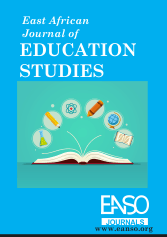The Influence of Gender Disparity on Girls’ Dropout Rates in Public Secondary Schools in Rwanda
Abstract
This study determined the influence of gender disparity on girls’ dropout rates in public secondary schools in Kicukiro and Gicumbi Districts in Rwanda. Grounded on Social Justice Theory, the study learned gender disparity in girls ‘dropout rates from 260 respondents using questionnaires. It adopted a pragmatist research paradigm, a quantitative research approach, and a descriptive research design. The findings revealed a positive correlation between gender disparity and girls' dropout rates in secondary schools. The study concludes that there are positive perceptions of gender disparity in public secondary schools, highlighting issues like harassment by teachers and the underrepresentation of female teachers highlight the need for improved policies and support systems to create a safe and encouraging environment for female students. The study recommends enforcing anti-harassment policies, expanding education access for low-income girls, increasing female teacher presence, and promoting gender parity to boost girls' academic success.
Downloads
References
Acquaye, C. C. (2021). Challenges facing the girl-child’s education and their coping strategies in the Ada East District, Ghana (Doctoral dissertation, University of Cape Coast).
Andiema, N. (2021). Influence of culture on girl child education in Central Pokot Sub County, Kenya. East African Journal of Education Studies, 3(1), 26-38. https://doi.org/10.37284/eajes.3.1.27
Asma, Z. & Pauline, R. (2018). Equitable Financing of Secondary Education in Sub-Suharan Africa: Research for Equitable Access and Learning (REAL) Centre, University of Cambridge. New York, USA.
Backer, D. I., & Cairns, K. (2021). Social reproduction theory revisited. British Journal of Sociology of Education, 42(7), 1086-1104.
Besharati, N. A., Fleisch, B., & Tsotsotso, K. (2021). Interventions to improve learner achievement in South Africa: A systematic meta-analysis. Systematic Reviews of Research in Basic Education in South Africa. African Sun Media, 27-67.
Bikorimana, G., Bimenyimana, P., Esther, N., Bahizi, M., Safari, K., & Joseph, H. (2024). Effect of Gender Based-Violence on the Social Well-being of Women in Rwanda. Case Study of Ngoma Sector, Huye District. Journal of Policy and Development Studies, 16(2), 192- 203.
Brzezicki, Ł., & Łącka, I. (2022). Cost efficiency of administrative service in public higher education in Poland. Scientific Papers of Silesian University of Technology Organization and Management. Economic and gender inequality. Oxfam
Clarke, M. (2021). British foreign and defence policy. In Politics UK (pp. 680-701). Routledge.
FAWE (2019), Celebrating Girls’ and Women Achievements in Education. Fawe Nairobi
Fraser, D., Weary, D. M., Pajor, E. A., & Milligan, B. N. (1997). A scientific conception of animal welfare that reflects ethical concerns. Animal welfare, 6(3), 187-205.
Greene, M. E., & Stiefvater, E. (2019). Social and gender norms and child marriage. A reflection on issues, evidence and areas of inquiry in the field. London: Advancing Learning and Innovations on Gender Norms (ALIGN). https://www.alignplatform.org/sites/default/files/201904/align_child_marriag_thinkpie.pd64–79. https://www.infed.org
Hair, E., Halle, T., Terry-Humen, E., Lavelle, B., & Calkins, J. (2006). Children's school readiness in the ECLS-K: Predictions to academic, health, and social outcomes in first grade. Early Childhood Research Quarterly, 21(4), 431-454.
Hashakimama, T. (2022). Influence of Family Social Economic Parameters on Internal Efficiency of Public Primary Schools in Western Province of Rwanda (Doctoral dissertation, University of Nairobi).
Jackson, C. K. (2021). Can introducing single-sex education into low-performing schools improve academics, arrests, and teen motherhood? Journal of Human Resources, 56(1), 1-39.
Kayanda, S. D. (2015). Examining Factors Affecting the Internal Efficiency of Education System in Community Secondary School (Doctoral dissertation, The Open University of Tanzania).
Martínez, D.G., & Vazquez-Heilig, J. (2022). An opportunity to learn: Engaging in the praxis of school finance policy and civil rights. Minnesota Journal of Law and Inequality, 40(2), 311334. Retrieved from https://lawandinequality.org/wpcontent/uploads/2022/05/Vol.- 402-Full-Issue.pdf.
Pritchett, L. (2019). Basic Education Services in World Bank Development Report 2004, Making Services Work for Poor People, Chapter 7. Washington D.C: World Bank
Raymond, A. (2020). Girls education in pastoral communities: An ethnographic study of Monduli District, Tanzania. UK: CfBT Education Trust.
Rizwan, M. (2024). Gender Equality in Education: Challenges and Opportunities. Zeal Journal of Multidisciplinary Research, 1(1), 26-32.)
Ruto, J. S. (2019). Sexual abuse of school age children: Evidence from Kenya. Journal of International Cooperation in Education 12, 1, 177-192.
Seshie, A. Z. (2019). Post-millennium development goals: analysis of education policies and gender inequity in basic education in Ghana a case study of Tema (Doctoral dissertation, College of Graduate and Postdoctoral Studies at the University of Saskatchewan).
Smith, S. G., & Sinkford, J. C. (2022). Gender equality in the 21st century: Overcoming barriers to women's leadership in global health. Journal of Dental Education, 86(9), 1144-1173.
Sperling, G. B., & Winthrop, R. (2016). What works in girls’ education: Evidence for the world’s best investment (p. 338). Brookings Institution Press. https://www.brookings.edu/wp-content/uploads/2016/07/What-Works-in-Girls-Educationlowres.pdf
Tukahabwa, D. (2018). Becoming Women ’Scientists’: Negotiating Gender Constructions of Science at University in Rwanda. Unpublished PhD Thesis. Canterbury: Canterbury Christ Church University.
UK Parliament (2020). Education for Girls-Hansard. [online] Available at Sperling, G. B., & Winthrop, R. (2016). What works in girls’ education: Evidence for the world’s best investment (p. 338). Brookings Institution Press. https://www.brookings.edu/wp-content/uploads/2016/07/What-Works-in-Girls-Educationlowres.pdf
United Nations Educational, Scientific, and Cultural Organization (UNESCO). (2020). Global education monitoring report: Gender report. Paris: UNESCO.
UNW, U. (2019). Progress of the world’s women 2019–2020. UN Women (UNW).
Wanjiru, G. (2023). Community attitudes and their impact on girls’ education in Kenya: A focus on pastoralist communities. Journal of African Education Research, 8(1), 20-35.
Warrington, M., & Kiragu, S. (2018). “It makes more sense to educate a boy”: Girls ‘against the odds’ in Kajiado, Kenya. International journal of educational development, 32(2), 301-309.
Zickafoose, A., Ilesanmi, O., Diaz-Manrique, M., Adeyemi, A. E., Walumbe, B., Strong, R., & Dooley, K. (2024). Barriers and challenges affecting quality education (Sustainable Development Goal#4) in sub-Saharan Africa by 2030. Sustainability, 16(7), 2657.
Copyright (c) 2025 Bonaventure Niyonshuti, Coletha Cleo Ngirwa, PhD, Karoli John Mrema, PhD

This work is licensed under a Creative Commons Attribution 4.0 International License.




























